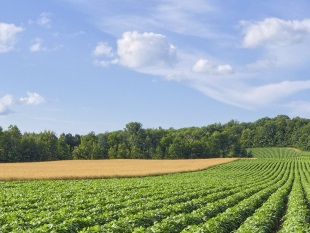At the Royal Society we are developing a programme on Living Landscapes to support the incorporation of scientific perspectives in post-Brexit land management policy.

The recently published Agriculture Bill represents a major opportunity to ensure a sustainable, productive and environmentally conscious future for how we manage our land. Science and technology will have a key role to play in realising this promise. Here at the Royal Society we are developing a programme on Living Landscapes to support the incorporation of scientific perspectives in post-Brexit land management policy.
The government has laid out a timeframe for the current arrangement of Direct Payments in place under the EU’s Common Agricultural Policy to be phased out by 2027, replaced with a new Environmental Land Management system. Rather than subsidising the quantity of land farmed, the new scheme will provide public money for the delivery of ‘public goods’. Public goods are those which produce a general, non-exclusive benefit which can be otherwise undervalued by the market. These could include environmental benefits or flood mitigation measures.
Public Money for Public Goods
Making the principle of ‘Public Money for Public Goods’ work in practice requires input from a broad swathe of interested parties, including social and natural scientists, farmers and industry. Difficult questions will need to be explored in detail. For example, how far should the public fund those goods which have both part public and part private characteristics? Promoting healthy livestock has both a broad public benefit and a benefit exclusive to the owner.
Agricultural fields edged with woodlandThe government has identified a range of broad areas they are interested in promoting through the new policy. These include:
- cleaner air and water
- healthier soil
- climate change mitigation
- thriving plants and wildlife
- enhanced animal health and welfare
Successful implementation will depend upon the intelligent application of science in achieving and measuring progress in these areas using evidence-based metrics. For example, the Royal Society recently brought together evidence on ammonia emissions from agriculture and assessed the practical interventions that could reduce these. Further examples could include how to accurately record biodiversity, identify and minimise the sources of microplastic contamination of freshwater, or quantify carbon sequestration in soils and woodland.
New technologies
Emerging technologies also have their role to play. A theme of our recent conference on microbiome research was the potential for biological interventions to improve soil health and supress disease. New land management methods such as precision farming and targeted fertiliser application can reduce the environmental impacts of agriculture while boosting margins. There is also increasing scope to use satellites to assess flood risk and water resources.
Not only can science contribute to environmental protection but it also holds the key to increased productivity. As science and technology continue to advance, they hold the potential to revolutionise the way we manage our land.
The Royal Society’s Living Landscapes programme aims to inform a long-term vision for how the UK manages its land post-Brexit, combining food production with the need to deliver positive environmental outcomes and other public goods. The programme will use a range of inclusive engagement techniques, and will include a range of evidence syntheses on specific topics.




